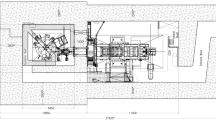Abstract
In view of public acceptance and the licensing procedure of projected fusion reactors, the release of tritium and activation products during normal operation as well as after accidents is a significant safety aspect. Calculations have been performed under accidental conditions for unit releases of corrosion products from water coolant loops, of first wall erosion products including different coating materials, and of tritium in its chemical form of tritiated water (HTO). Dose assessments during normal operation have been performed for corrosion products from first wall primary coolant loop and for tritium in both chemical forms (HT/HTO). The two accident consequence assessment (ACA) codes UFOTRI and COSYMA have been applied for the deterministic dose calculations with nearly the same input variables and for several radiological source terms. Furthermore, COSYMA and NORMTRI have been applied for routine release scenarios. The paper analyzes the radioation doses to individuals and the population resulting from the different materials assumed to be released in the environment.
Similar content being viewed by others
References
W. Raskob, O. Edlund, and W. Gulden. Doses due to Accidental releases of Tritium and Activation Products into the Atmosphere and the Aquatic Environment. Proceedings of the 17th Symposium on Fusion Technology, Rome, 14.9.92–18.9.92 (to be published).
G. Cambiet al. (1993). Activation Evaluation for AISI-316L NET/ITER Outboard First Wall with Be, Be4C, W, or Graphite Coating/Tile Materials. DOC FUS S + E Tr 01/93.
W. Gulden. Required Definition Document, S+E, Subtask SEP2.2: Doses to the Public. NET-Doc.: N/S/0262/1/A + N/S/0262/2/A.
COSYMA. A New Program Package for Accident Consequence Assessments; A Joint Report of KfK and NRPB; Commission of the European Communities, Report EUR-13028, 1991.
J. Straka, H. GeiB and K. J. Vogt (1981). Diffusion of Waste Air Puffs and Plumes Under Changing Weather Conditions. Contr. Atm. Phys., Vol. 54, p. 207.
Der Bundesminister für Umwelt Naturschutz und Reaktorsicherheit. Allgemeine Verwaltungsvorschrift zu § 45 StrSch V, Bundesanzeiger 42, Nr. 64a, 212.1990, Bonn, 1990.
Isaak Van der Hoven (1976). A survey of field measurements of atmospheric diffusion under low-wind speed inversion conditions.Nucl. Safety 17, 223–230.
W. Raskob (1992). Modelling of the Tritium Behaviour in the Environment. Proceedings of the 4th Topical Meeting on Tritium Technology in Fission, Fusion and Isotopic Applications, Albuquerque, 29.9.91–4.10.91,Fusion Technol. 21,(2) 636–645.
P. V. Shaw and S. M. Haywood (1986). A dynamic model for predicting the movement of tritium in the environment.Radiation Protection Dosimetry 16,(1–2), 59–62.
W. Raskob. NORMTRI: Program for Assessing the Off-Site Consequences from Tritium Releases Under Normal Operating Conditions; Report KfK (to be published).
W. Raskob and I. Hasemann (1992). Results of Dose Calculations for NET Accidental and Normal Operation Releases of Tritium and Activation Products; Report KfK-5028, Kernforschungszentrum Karlsruhe.
A. Fiege (ed.) (1992). Tritium, Report KfK-5055, Kernforschungszen Karlsruhe.
J. Raederet al. (1991). ITER Safety; ITER Documentation Series No. 36, IAEA, Vienna.
Author information
Authors and Affiliations
Additional information
D.T.I. Dr. Trippe Ing. GmbH, Karlsruhe.
Rights and permissions
About this article
Cite this article
Raskob, W. Doses from accidental releases of tritium and activation products into the atmosphere. J Fusion Energ 12, 149–156 (1993). https://doi.org/10.1007/BF01059371
Issue Date:
DOI: https://doi.org/10.1007/BF01059371




